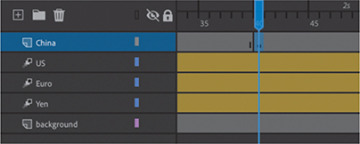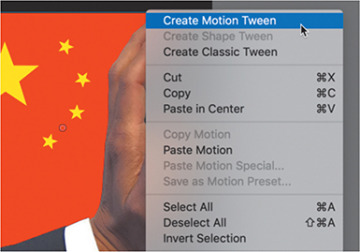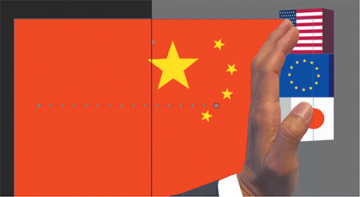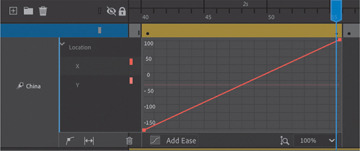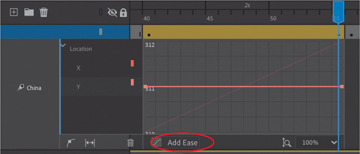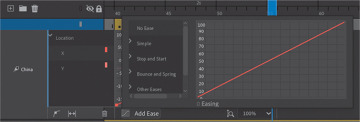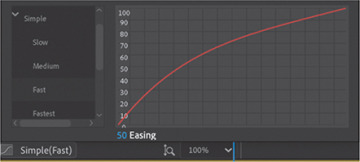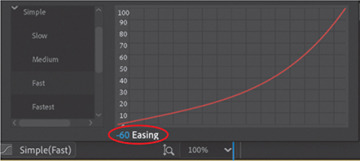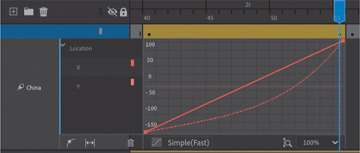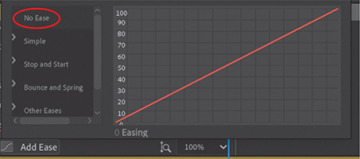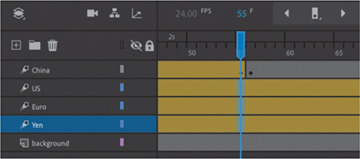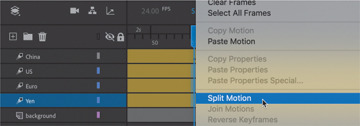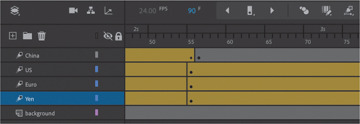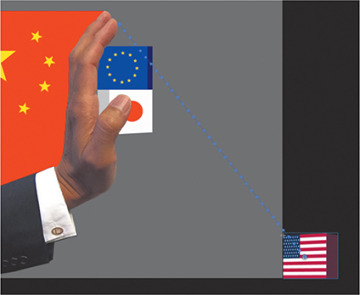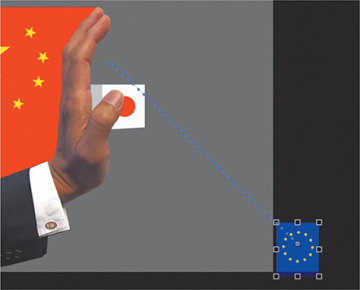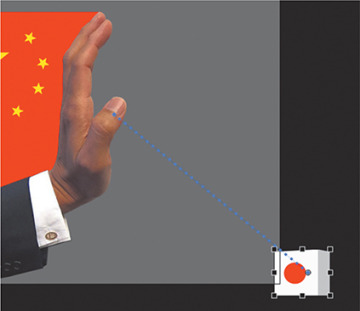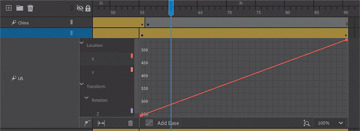Adding complex eases
Now that your three blocks representing the US, European Union, and Japanese currencies are animated, it’s time to animate the hand that pushes them. The hand will move horizontally onto the Stage and give the stack of blocks a shove, sending them toppling.
The motion of the hand easing into the Stage and the toppling motion can be quite complex. As the blocks topple, they bounce up and down, decreasing in height after each bounce. The Motion Editor, fortunately, makes much of the motion quick and easy to edit.
Adding the next motion tween
The next motion tween will be applied to the hand of China. The movie clip is positioned just off the left of the Stage, in the layer called China.
Select frame 90 for all the layers, and press F5 (Insert > Timeline > Frame).
Animate adds frames to all the layers up to frame 90. This establishes the span of time for the hand to enter and knock over the blocks.
Select frame 40 in the China layer and insert a new keyframe (F6) to define the moment when the hand starts to move.
The movie clip instance from the previous keyframe is copied into the new keyframe.
Right-click the China movie clip instance just off the Stage and choose Create Motion Tween.
Move the playhead to frame 55, the point where we want the hand to make contact with the blocks.
Move the hand straight across the Stage so that its palm butts up against the stack of blocks. (Use the Right Arrow key to keep the movie clip’s motion restricted to a horizontal direction.) The X-position of the instance should be at about 2. Make sure that the Y-position remains at Y=210 in the ending keyframe, as in the beginning keyframe.
The China movie clip instance is now animated, and it moves straight across the Stage from left to right and stops at frame 55. The movie clip stays at its ending position from frame 55 to frame 90.
Select frame 56 of the China layer.
Right-click and choose Split Motion.
The motion tween in the China layer is split into two motion tweens—one that begins at frame 40 and another that begins at frame 56.
At frame 56, right-click and choose Remove Motion Tween.
The motion tween at frame 56 is deleted, leaving the movie clip instance as a static graphic from frame 56 to the last frame of the animation. The motion tween from frame 40 to frame 56 is now ready for an ease.
Adding an ease-in
The Motion Editor provides a host of different ease types that can give a simple motion, like the China movie clip’s shove, a more interesting effect.
Double-click the motion tween in the China layer, or right-click and choose Refine Motion Tween.
The Motion Editor opens to reveal property curves for both the X- and Y-properties. The X-property curve is angled upward, whereas the Y-property curve is relatively flat.
Select the X-property curve.
Click the Add Ease button at the bottom of the Motion Editor.
The Ease panel opens, listing the different ease presets grouped by category, from No Ease at the top to Custom Ease at the bottom. The different ease presets change the way the motion tween proceeds from the first keyframe to the last.
Double-click the Simple category.
The category opens, revealing Slow, Medium, Fast, and Fastest presets. The eases in the Simple category affect one side of the motion tween (either the beginning or the end). The eases in the Stop and Start categories affect both sides of the motion tween. The eases in the other categories are more complex ease types.
Select the Fast ease preset.
The Fast ease curve is displayed, showing graphically the intensity of the ease. Slower eases are fairly shallow and closer to a straight line, whereas faster eases have progressively greater curvature.
Double-click the Easing value and change it to −60; then press Tab or Return/Enter to exit the entry field and confirm the value. You can also drag on the Easing value to change it (drag left or down to decrease the value; drag right or up to increase it).
The Easing value determines the strength of the ease for each ease preset and the direction of the ease. A positive number represents an ease-out, and a negative number represents an ease-in.
Click off the Ease panel to dismiss it, or press the Esc key.
A dotted line appears in the Motion Editor superimposed on the original property curve. This is called the “resultant curve” and shows the effect of the ease on the tween.
Close the Motion Editor and test your new motion by pressing Return/Enter.
The motion tween of the China block proceeds slowly, gaining momentum until it finally collides with the stack of smaller blocks in the middle of the Stage.
If the motion tween is selected, its motion tween path on the Stage shows the position of the instance at each frame. The clustering of the dots on the left side of the tween path means that the object doesn’t move very far in the beginning of its motion but gradually speeds up.
Removing an ease
Eases can be deleted as quickly as you’ve added them.
Double-click the motion tween in the China layer, or right-click and choose Refine Tween.
Click the Ease button at the bottom of the Motion Editor, which now bears the label Simple (Fast).
Animate opens the Ease panel, displaying the currently selected ease.
Select No Ease to remove the ease preset, and press Esc to close the Ease panel.
Press Command+Z (macOS)/Ctrl+Z (Windows) to undo the removal of the ease. You’ll keep the ease in place for this project.
Double-click the China motion tween to close the Motion Editor.
Animating bounces
As soon as the hand graphic hits the stack of blocks, you’ll want to animate the blocks tumbling down. You’ll create a motion tween with multiple complex eases to create the bouncing effect.
Drag to select frame 55 in the US, Euro, and Yen layers. (If you are using span-based selection, hold down Command/Ctrl while you drag.)
Right-click and choose Split Motion.
New motion tweens begin at frame 55 in all three layers.
Move the playhead to frame 90.
Move the US movie clip instance to the right of the bottom of the Stage at X=500 and Y=530.
Using the Free Transform tool, rotate it 180 degrees clockwise so that it appears upside down.
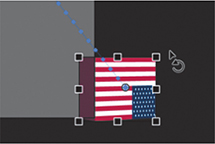
Move the Euro movie clip instance to the bottom just off the Stage in the same manner and use the Free Transform tool to rotate it 90 degrees clockwise. You may have to hide the US layer above it so that you can grab the Euro graphic.
Move the Yen movie clip instance to the bottom just off the Stage and use the Free Transform tool to rotate it 180 degrees clockwise. Hide the Euro layer so that the Yen graphic is easier to work with.
Test your new motion by pressing Return/Enter.
The three blocks fall gracefully in a diagonal direction, rotating as they fall. You’ll want a more violent, realistic tumble, so the next step is to add some eases.
Using the BounceIn ease
One of the presets in the Ease panel is BounceIn, which simulates a bouncing motion. The distance to the final property value gradually decreases as the motion tween approaches its ending keyframe.
Double-click the last motion tween in the US layer to open the Motion Editor.
Animate expands the motion tween in the US layer, revealing the Motion Editor panel. The Motion Editor contains property curves for both the X- and Y-properties for Location as well as the Z-property for Transform > Rotation.
Select the Y-property under Location.
Click Add Ease at the bottom of the Motion Editor to open the Ease panel.
Double-click the Bounce And Spring category to reveal the presets within.
Select the BounceIn ease preset and enter 5 for the Easing value.
The BounceIn ease simulates a bounce that slowly decays as the motion tween approaches its end. The Easing value for the BounceIn ease determines the number of bounces.
Press Tab to confirm the Easing value and press Esc to close the Ease panel.
Test your new motion by pressing Return/Enter.
The US instance bounces (only in the Y-direction) as it falls to the ground. Note the path of the bounce on the Stage defined by the dots.
Collapse the Motion Editor for the US layer, and expand the Motion Editor for the Euro layer.
Apply a BounceIn ease to the Euro instance, and change the Easing value to 4.
Collapse the Motion Editor for the Euro layer, and expand the Motion Editor for the Yen layer.
Apply a BounceIn ease to the Yen instance, and change the Easing value to 3.
Test your new motion by pressing Return/Enter.
When the three blocks fall, each tumbles with a different number of bounces. The top block bounces the most with five bounces, the middle bounces four times, and the bottom block bounces three times.
Applying a second ease to a different property curve
The Motion Editor is powerful because it enables you to treat each property curve of one motion tween independently. For example, you can apply one ease for the Y-property and a different ease for the X-property. This is exactly what you’ll do next. You’ll add an ease-out for the horizontal motion of each instance, while maintaining the BounceIn ease for the vertical motion.
Expand the Motion Editor for the US layer.
Select the X-property under Location.
Click Add Ease at the bottom of the Motion Editor to open the Ease panel.
Double-click the Simple category.
Select the Fast ease preset and enter 50 for the Easing value.
The Easing value of 50 represents a strong ease-out motion.
Apply Fast eases with an Easing value of 50 for the X-property curves of the other two motion tweens (the Euro and the Yen instances).
Test your new motion by pressing Return/Enter.
As the three blocks bounce to the ground in the Y-direction, their forward momentum gradually slows down, creating a more realistic animation in the X-direction.
Review questions
1 How do you access the Motion Editor for a motion tween?
2 What’s the difference between a property curve and an ease curve?
3 What does the Easing value do to an ease?
4 How do you change the curvature of a property curve?
Review answers
1 To open the Motion Editor panel, double-click a motion tween span on the timeline, or right-click a motion tween span and choose Refine Motion Tween.
2 A property curve is the graphical representation of how a property of a motion tween changes values over time. An ease curve represents a different rate of change that you can apply to an individual property curve. Animate displays the effects of an ease curve on a property curve as a dotted line.
3 The Easing value changes the strength and direction of an ease. Easing values affect eases differently, depending on the type of ease selected. For example, the Easing value for BounceIn eases determines the number of bounces, whereas the Easing value for a Simple Fast ease determines whether the ease is an ease-in or ease-out, and the strength of the ease.
4 To change the curvature of a property curve, select the property in the Motion Editor and select Add Anchor. Click the curve to add a new anchor point and move the direction handles to change the shape of the curve at that point. You can move the anchor points up or down to change the property value, or you can move the anchor points left or right to change the position of the keyframe within the motion tween.

